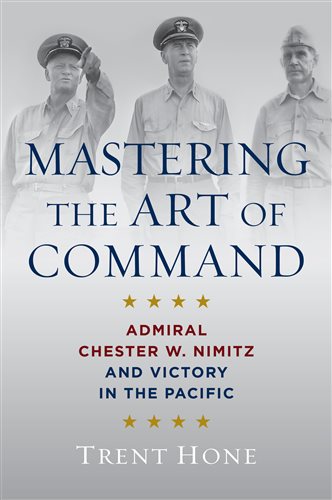
Mastering the Art of Command; Admiral Chester W Nimitz and Victory in the Pacific. By Trent Hone. Naval Institute Press, Annapolis, 2022.
Reviewed by Tim Coyle PhD
There is no shortage of Pacific War histories and studies on leadership command qualities; the extensive notes and bibliography to Mastering the Art of Command illustrates this. Author Trent Hone, a specialist in leadership and organisational structures, examines and analyses Admiral Chester Nimitz’s leadership in the dual roles of as Commander-in-Chief Pacific and Commander-in-Chief Pacific Ocean Area.
Mastering the Art of Command comprises 10 chapters of narrative, from Pearl Harbor to planning for Operation Olympic – the invasion of the Japanese home islands. The book’s Conclusion expands on Nimitz’s command philosophy and his relationships with national command and senior subordinates.
Chester Nimitz came to command in the between-war period; a time during which the US Navy advocated its officers view command through decentralised authority and clear mission direction which, in turn, encouraged initiative in subordinates. In modern terminology, it might be expressed as ‘driving decision-making down’. Personal relationships were integral to this philosophy and were built up over years of inter-personal familiarity. A series of interwar ‘Fleet Problems’ engendered strategic and tactical thinking applied to new technologies in relation to a Pacific war against the emergent Imperial Japanese Navy.
Nimitz’s leadership qualities were honed during his early-1930s period in command of the cruiser USS Augusta, then Asiatic Fleet flagship. A junior officer in Augusta, who subsequently achieved flag rank, observed Nimitz’s charge to his officers and sailors that ‘…here’s the job to be done, here are the conditions under which it is prescribed to be done. We’re going to go out, and not only are we going to do it, but we’re going to do it better than anyone else. We’re going to do it as close to perfection as human limitations permit. And we’re never going to be content with anything short of that’.
Many commanders have exhorted their commands in similar rhetoric over the ages, some of which achieved the desired outcomes while others failed, largely through personal shortcomings of the commander. However, Nimitz proved his mastery of this philosophy through the ultimate test of the Pacific maritime war.
Trent Hone’s Conclusion distils the vast Nimitz narrative into its vital elements. These comprise Collaborative Sensemaking (‘the action or process of making sense of, or giving meaning to something, especially new developments and experiences’), Decentralized Execution, Organizational Unfolding, Continual Reorientation, Relentless Pursuit of Options and Strategic Artistry.
Nimitz used these elements in his dealings with Admiral Ernest King, Chief of Naval Operations and the Joint Chiefs of Staff, General Douglas MacArthur, supreme commander, South-West Pacific, (different in temperament and command philosophy to Nimitz), and his subordinate commanders. He kept his staff relatively small, and his daily morning conferences allowed for advancement of ideas conforming with these elements. He sought the best subordinate commanders, overlooking initial missteps where he saw longer term strengths, while moving on less effective commanders without rancour. He was aggressive and a calculated risk-taker (Midway and advocating Guadalcanal as a strategic campaign).
Mastering the Art of Command is well-researched, with a concise and comprehensive narrative of Nimitz’s command decisions and strategy which Trent Hone expertly analyses. As such, it is a fine addition to the history of the Pacific war and the study of leadership.


